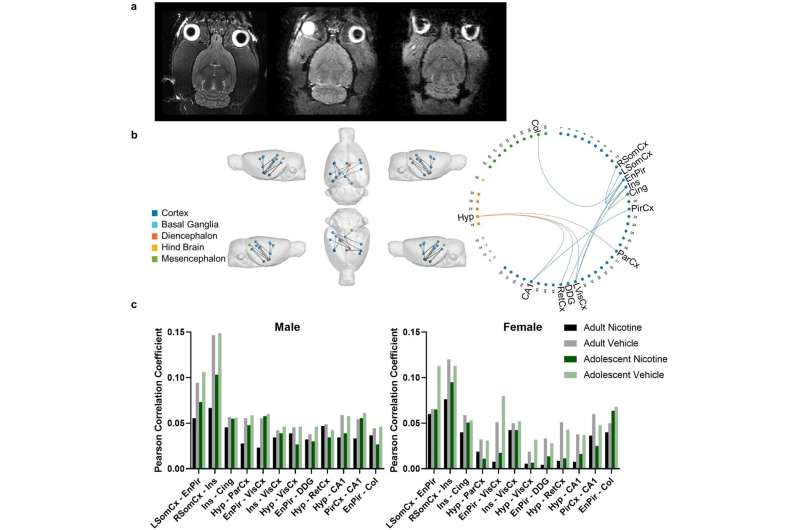Although vaping has become popular, researchers say methods to study the effects of vapor inhalation are limited. Credit: Pexels/Olena Bohovyk
Vapes or electronic cigarettes have been introduced as a potentially safer alternative to traditional smoking to reduce tobacco consumption. However, the popularity of vapes has increased among an age group they were not intended for: teenagers.
While the full health effects of vaping are yet to be revealed, previous research has shown that one in four high school students in Canada reported vaping in the past 30 days, and nearly 12% of among them reported having used nicotine vapes exclusively.
A new study, published in the journal Neuropsychopharmacologyexamined the effects of nicotine vapor exposure in rat models to understand nicotine-induced reward and withdrawal behaviors, brain connectivity, and how the body processes nicotine.
The study, led by Occidental professor Jibran Khokhar and graduate student and Vanier scholarship winner Jude Frie, showed that gender and age factors influence the body’s response to nicotine vapor.
“Using exposure pathway and brain circuit assessment methods similar to those used in humans, the results obtained here can hopefully demystify the effects of nicotine vaping on the human brain from “adolescent and adult, as well as the important role that gender plays in these effects,” said Khokhar, Canada Research Chair in Translational Neuropsychopharmacology and professor in the Schulich School of Medicine & Dentistry at Western .
The study showed that adult female rats were more likely to acquire a preference for longer exposures to nicotine vapor, while adolescent female rats, as well as adult and adolescent male rats, did not show the same level preferably.
Additionally, adult and adolescent male rats exhibited withdrawal symptoms and increased activity due to exposure to nicotine vapor, whereas female rats did not exhibit these symptoms.
The study also found that adult women had higher levels of nicotine in their bodies and brains than adult men and adolescent girls.

Reduced functional connectivity was observed in rats exposed to nicotine vapor, with greater reductions observed in female rats. A Representative anatomical image of a single subject T2 (left), b=0 diffusion image (middle), and first volume of an fMRI dataset (right). b NBS statistics confirmed reduced functional connectivity in the Nicotine group (not = 34) compared to the Vehicle group (not = 36) taking into account age and sex (p= 0.013, 12 edges, 13 nodes). Important edges have labeled anatomical regions. All other regions carry the numerical reference of their SIGMA atlas. vs Mean Pearson correlation coefficients in edges identified by NBS statistics as having reduced functional connectivity in the Nicotine group when controlling for age and sex (p= 0.013, 12 edges, 13 nodes). A post-hoc analysis confirmed a statistically significant group by sex interaction effect (p< 0.001, 5 edges, 6 nodes). No statistically significant group by age interaction effect was confirmed. Abbreviations: L left, R right, Hyp Hypothalamus, ParCx Parietal Cortex, PirCx Piriform Cortex, EnPir Endo/piriform Cortex, VisCx Primary and Second Visual Cortex, CA1 Cornu Ammonis 1, SomCx Primary Somatosensory Cortex, Ins Insular Cortex, Cing Cingulate Cortex, DDG Dorsal dentate gyrus, retrosplenial cortex RetCx, Col Colliculus. Credit: Neuropsychopharmacology(2023). DOI: 10.1038/s41386-023-01773-3
“Brain connectivity in nicotine-exposed rats was altered, indicating that vaping affects the brain differently depending on age and sex,” Khokhar said. Understanding these complexities is essential not only for addressing the risks associated with vaping, but also for developing effective strategies to protect vulnerable populations, particularly youth, from the potential harms of e-cigarette use.
“This study also highlights the importance of being aware of gender differences in drug elimination, which would then alter the effects of drugs. Far too often the same doses are used in both sexes, but how much of drugs actually reaches the brain or the blood is never tested,” Khokhar said.
Open source methods for studying the effects of nicotine vapor
Although vaping has become popular, methods to study the effects of vapor inhalation are limited. The team of researchers led by Khokhar developed an open source device to conduct research on the behavioral and physiological effects of vaping, particularly in rodents.
The device, called OpenVape, is inexpensive and can be customized to work with different types of vaporizers. This includes not only e-cigarettes, but also other vaporizers designed for different substances, such as nicotine pods, tanks, cannabis flowers or concentrates.
“By using open source tools like our OpenVape system, this type of study becomes accessible to researchers from diverse backgrounds. Importantly, we hope that by reducing the barriers to entry for performing this type of research, we will be able to launch “Additional avenues of research by other groups to learn more about this urgent topic of great public health importance,” Khokhar said.
More information:
Jude A. Frie et al, Factors influencing reward, withdrawal, pharmacokinetics and brain connectivity induced by nicotine vapor from the JUUL electronic cigarette in rats: sex matters, Neuropsychopharmacology(2023). DOI: 10.1038/s41386-023-01773-3
Provided by the University of Western Ontario
Quote: New study on vapes challenges belief that teens have less severe withdrawal symptoms (December 7, 2023) retrieved December 7, 2023 from
This document is subject to copyright. Apart from fair use for private study or research purposes, no part may be reproduced without written permission. The content is provided for information only.



